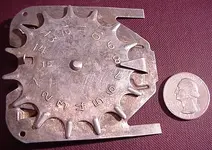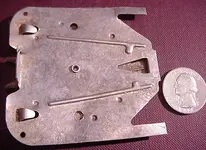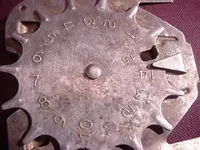Thanks for responding but your logic is seriously flawed. We have been over this all before. You said you are not familiar with electronic engineering. (I was hoping you were). I am an HVAC/refrigeration technician for 30 years and I see no way possible that this simple device could have attached to anything else. The sprocket wheel is connected with a simple rivet. There is no way for it to connect to a control.
I'm not sure if you understand, but think of the knobs on your metal detector that may go from 1-15. The knob has to have a shaft to connect to the electronic control. WE HAVE NO SHAFT and there is no way this rivet can connect to a shaft. As Bob says there is no way, shape, or form this is directly related to anything electronic. That is why I asked you to draw a diagram explaining how this would be done. And please don't say it can be attached by the tabs.
I agree that the golf club sized thingies are to allow the wheel to rotate freely or to raise it slightly off the surface and this was realized long ago. This is another clue going against an electronic control. A control that is attached permanently by the shaft does not need these thingies to keep it raised. My experiment with wire fence showed that these angled golf club things made sure the bottom rivet would never touch the fence so as to spin freely. It also stiffened the entire assembly keeping it tight on the fence wire..
Ill copy and paste Bobs quote as it is appropriate:
Everyone knows I'm like a bloodhound and will follow any trail that has a bonified scent to it. And I will do the same with anyone who can show me one iota of true-blue "evidence," (Image is best), showing that the device is in any way, shape, or form directly, or indirectly, related to anything "electronic," as opposed to it being a simple, manually operated invention. Again, none of what I or others have produced "proves" it is an egg tallying device, only that so far this is where the best "evidence" has led us.
Again thanks for posting and your thoughts are always welcome but until someone can draw a decent diagram showing how this would attach to a heating control, or any control for that matter, we have to rule it out.
[/quote]
Seriously flawed logic huh, that's almost an insult. First and foremost, the simple fact that the wheel lacks a zero indicates that it is not a device used to count anything, this is simple logic. I looked up a bunch of the egg counter patents and they all included zero on their counting devices, as does the one pictured above. I do not think there is a numeric system without a null value. Also the numbers 1-14 and or 15 do not seem to relate to anything that anyone would typically count or keep track of. If I designed an egg counter it would be base twelve and have at least the capacity to count to 144, twelve dozen.
Also I never said that I was 100% sure it was part of an electric device. Just that it is the most likely. Heater, yeah again the most likely choice, heating devices would outnumber refrigerators at least 10 to 1. If it was I will attempt describe how the assembly would be as I picture it. I never said that the wheel was attached at the hub/rivet. Here are some examples of how it could have been part of a mechanism electric or not: The little tab may have had a "bakelite" or similar material block that slid onto the tab. Attached to this would be a copper contact that had a wire attachment tab and a contact that would rest against a rheostat(or maybe potentiometer?) that would be either attached to another mounting plate/bracket that resided concentrically above the numbered wheel. As you moved the dial the contact would rotate against rest of the potentiometer. The single thing that tells me it is likely electric is the fact the the 15 (highest setting)is accessible from the 1 (lowest) position without rotating the dial 360 degrees. Potentiometers work in this fashion and it would be a desireable feature. Or it could have been assembled in such a way so the tab stuck up and into a slot in the potentiometer control arm. Most Potentiometers cannot be rotated more than 360 degrees, this is to keep the wire on the control arm from twisting up and eventually breaking. the The holes in the wheel mounting plate would have locater pins from the next assembly in them so it would be properly positioned. The device cover would be a cap that snapped over the assembly with the three tabs in slots or notches properly locating the device. Alternately it could have just resided inside an appliance with the viewing opening and adjustment wheel opening incorporated into the appliance itself. Another scenario is that there was a coil, spring or linkage that fit over the tab and remotely controlled the electrics. Also I mentioned that it may not have been electric but a totally mechanical device that may control a damper or similar item. I have described at least 4 or 5 different ways for it to be used that are all well thought out, imo, if my logic is flawed so be it. Any way I guess I will learn photoshop and paint to help you visualize what I describe.











 Dont get any hard feeling here its not necessary.
Dont get any hard feeling here its not necessary. 
 I always figured the tab was a stop, nothing else. I apologize to both of you if I didnt understand. I will try to study it.
I always figured the tab was a stop, nothing else. I apologize to both of you if I didnt understand. I will try to study it. 